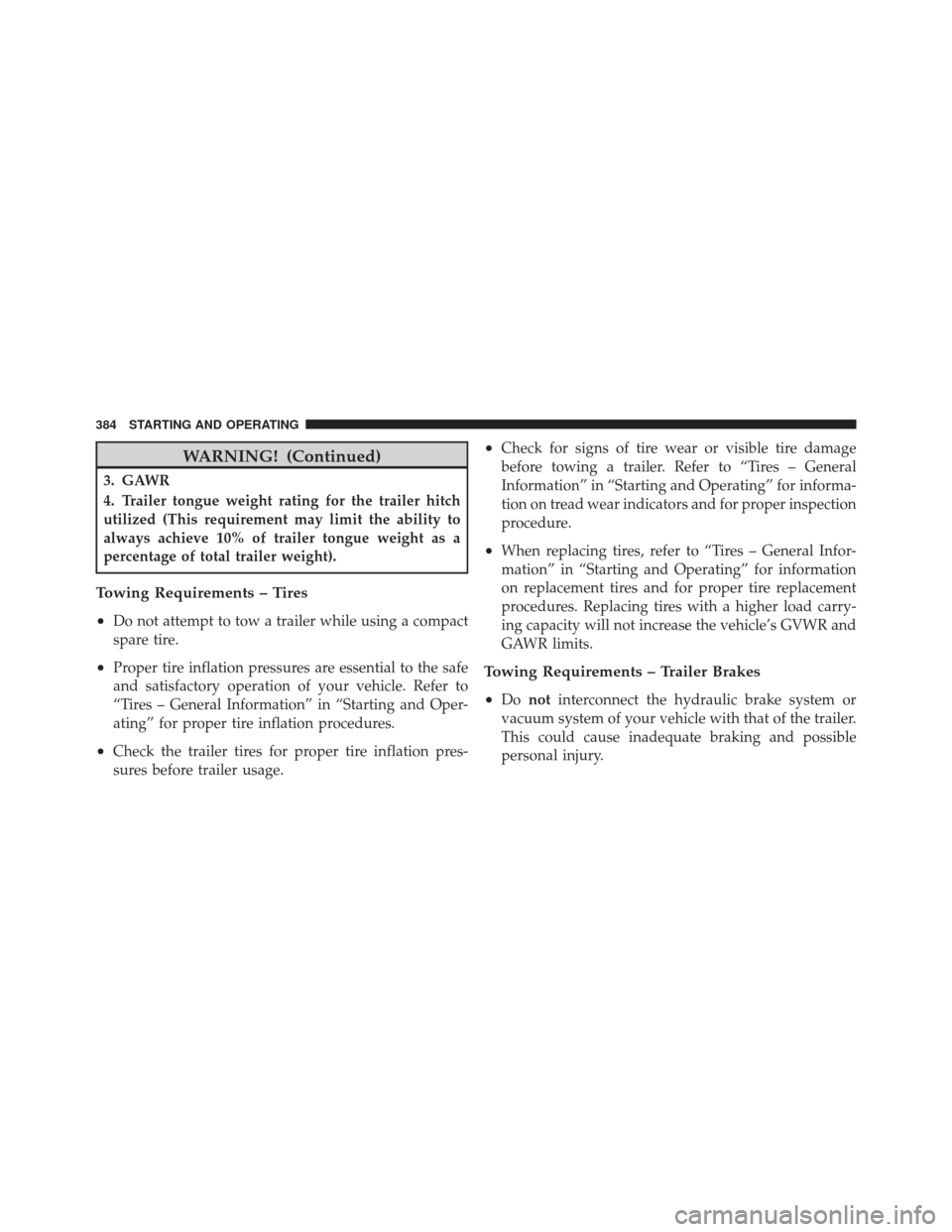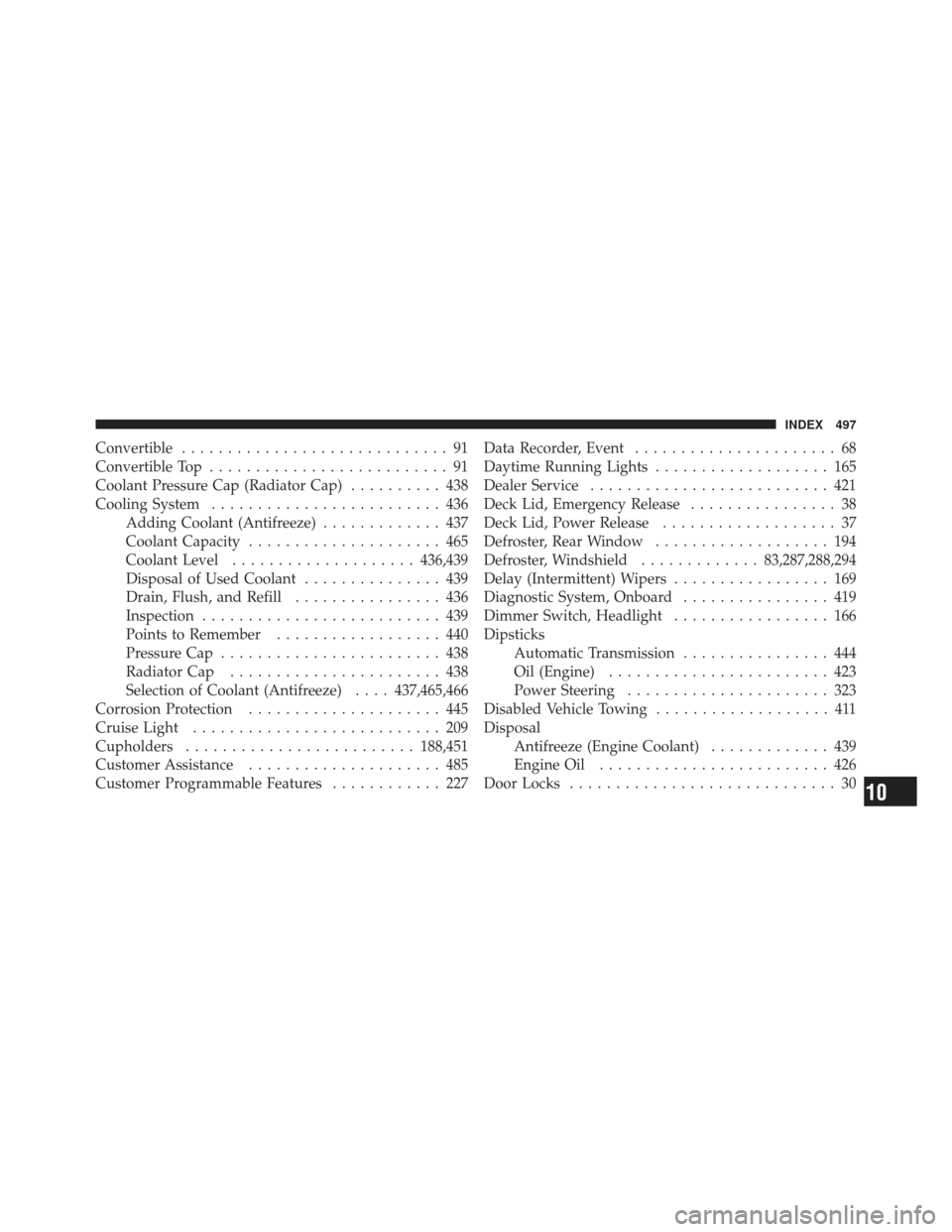towing capacity CHRYSLER 200 CONVERTIBLE 2012 1.G Owners Manual
[x] Cancel search | Manufacturer: CHRYSLER, Model Year: 2012, Model line: 200 CONVERTIBLE, Model: CHRYSLER 200 CONVERTIBLE 2012 1.GPages: 517, PDF Size: 3.17 MB
Page 343 of 517

Loading
The vehicle maximum load on the tire must not exceed
the load carrying capacity of the tire on your vehicle. You
will not exceed the tire’s load carrying capacity if you
adhere to the loading conditions, tire size, and cold tire
inflation pressures specified on the Tire and Loading
Information placard and in the “Vehicle Loading” section
of this manual.
NOTE:Under a maximum loaded vehicle condition,
gross axle weight ratings (GAWRs) for the front and rear
axles must not be exceeded. For further information on
GAWRs, vehicle loading, and trailer towing, refer to
“Vehicle Loading” in this section.
To determine the maximum loading conditions of your
vehicle, locate the statement “The combined weight of
occupants and cargo should never exceed XXX lbs or
XXX kg” on the Tire and Loading Information placard. The combined weight of occupants, cargo/luggage and
trailer tongue weight (if applicable) should never exceed
the weight referenced here.
Steps For Determining Correct Load Limit
1. Locate the statement “The combined weight of occu-
pants and cargo should never exceed XXX lbs or XXX kg”
on your vehicle’s placard.
2. Determine the combined weight of the driver and
passengers that will be riding in your vehicle.
3. Subtract the combined weight of the driver and pas-
sengers from XXX lbs or XXX kg.
4. The resulting figure equals the available amount of
cargo and luggage load capacity. For example, if “XXX”
amount equals 1,400 lbs (635 kg) and there will be five
150 lb (68 kg) passengers in your vehicle, the amount of
5
STARTING AND OPERATING 341
Page 344 of 517
![CHRYSLER 200 CONVERTIBLE 2012 1.G Owners Manual available cargo and luggage load capacity is 650 lbs
(295 kg) (since 5 x 150 = 750, and 1400 – 750 = 650 lbs
[295 kg]).
5. Determine the combined weight of luggage and cargo
being loaded on the vehi CHRYSLER 200 CONVERTIBLE 2012 1.G Owners Manual available cargo and luggage load capacity is 650 lbs
(295 kg) (since 5 x 150 = 750, and 1400 – 750 = 650 lbs
[295 kg]).
5. Determine the combined weight of luggage and cargo
being loaded on the vehi](/img/25/8446/w960_8446-343.png)
available cargo and luggage load capacity is 650 lbs
(295 kg) (since 5 x 150 = 750, and 1400 – 750 = 650 lbs
[295 kg]).
5. Determine the combined weight of luggage and cargo
being loaded on the vehicle. That weight may not safely
exceed the available cargo and luggage load capacity
calculated in Step 4.
6. If your vehicle will be towing a trailer, load from your
trailer will be transferred to your vehicle. Consult this
manual to determine how this reduces the available
cargo and luggage load capacity of your vehicle.NOTE:
•The following table shows examples on how to calcu-
late total load, cargo/luggage, and towing capacities
of your vehicle with varying seating configurations
and number and size of occupants. This table is for
illustration purposes only and may not be accurate for
the seating and load carry capacity of your vehicle.
•For the following example, the combined weight of
occupants and cargo should never exceed 865 lbs
(392 kg).
342 STARTING AND OPERATING
Page 386 of 517

WARNING! (Continued)
3. GAWR
4. Trailer tongue weight rating for the trailer hitch
utilized (This requirement may limit the ability to
always achieve 10% of trailer tongue weight as a
percentage of total trailer weight).
Towing Requirements – Tires
•
Do not attempt to tow a trailer while using a compact
spare tire.
•Proper tire inflation pressures are essential to the safe
and satisfactory operation of your vehicle. Refer to
“Tires – General Information” in “Starting and Oper-
ating” for proper tire inflation procedures.
•Check the trailer tires for proper tire inflation pres-
sures before trailer usage.
•Check for signs of tire wear or visible tire damage
before towing a trailer. Refer to “Tires – General
Information” in “Starting and Operating” for informa-
tion on tread wear indicators and for proper inspection
procedure.
•When replacing tires, refer to “Tires – General Infor-
mation” in “Starting and Operating” for information
on replacement tires and for proper tire replacement
procedures. Replacing tires with a higher load carry-
ing capacity will not increase the vehicle’s GVWR and
GAWR limits.
Towing Requirements – Trailer Brakes
•
Donot interconnect the hydraulic brake system or
vacuum system of your vehicle with that of the trailer.
This could cause inadequate braking and possible
personal injury.
384 STARTING AND OPERATING
Page 387 of 517

•An electronically actuated trailer brake controller is
required when towing a trailer with electronically
actuated brakes. When towing a trailer equipped with
a hydraulic surge actuated brake system, an electronic
brake controller is not required.
•Trailer brakes are recommended for trailers over
1,000 lbs (450 kg) and required for trailers in excess of
2,000 lbs (907 kg).
CAUTION!
If the trailer weighs more than 1,000 lbs (450 kg)
loaded, it should have its own brakes with adequate
braking capacity. Failure to do this could lead to
accelerated brake lining wear, higher brake pedal
effort, and longer stopping distances.
WARNING!
•Do not connect trailer brakes to your vehicle’s
hydraulic brake lines. It can overload your brake
system and cause it to fail. You might not have
brakes when you need them and could have a
collision.
•Towing any trailer will increase your stopping
distance. When towing, you should allow for ad-
ditional space between your vehicle and the ve-
hicle in front of you. Failure to do so could result
in a collision.
Towing Requirements – Trailer Lights And Wiring
Whenever you pull a trailer, regardless of the trailer size,
stop lights and turn signals on the trailer are required for
motoring safety.
5
STARTING AND OPERATING 385
Page 499 of 517

Convertible............................. 91
Convertible Top .......................... 91
Coolant Pressure Cap (Radiator Cap) .......... 438
Cooling System ......................... 436
Adding Coolant (Antifreeze) ............. 437
Coolant Capacity ..................... 465
Coolant Level .................... 436,439
Disposal of Used Coolant ............... 439
Drain, Flush, and Refill ................ 436
Inspection .......................... 439
Points to Remember .................. 440
Pressure Cap ........................ 438
Radiator Cap ....................... 438
Selection of Coolant (Antifreeze) ....437,465,466
Corrosion Protection ..................... 445
Cruise Light ........................... 209
Cupholders ......................... 188,451
Customer Assistance ..................... 485
Customer Programmable Features ............ 227Data Recorder, Event
...................... 68
Daytime Running Lights ................... 165
Dealer Service .......................... 421
Deck Lid, Emergency Release ................ 38
Deck Lid, Power Release ................... 37
Defroster, Rear Window ................... 194
Defroster, Windshield .............83,287,288,294
Delay (Intermittent) Wipers ................. 169
Diagnostic System, Onboard ................ 419
Dimmer Switch, Headlight ................. 166
Dipsticks Automatic Transmission ................ 444
Oil (Engine) ........................ 423
Power Steering ...................... 323
Disabled Vehicle Towing ................... 411
Disposal Antifreeze (Engine Coolant) ............. 439
Engine Oil ......................... 426
Door Locks ............................. 30
10
INDEX 497
Page 512 of 517

Tilt Steering Column..................... 172
Time Delay, Headlight .................... 163
Tip Start .............................. 305
Tire and Loading Information Placard ......... 340
Tire Identification Number (TIN) ............. 338
Tire Markings .......................... 334
Tire Safety Information .................... 334
Tires ............................ 85,344,491
Aging (Life of Tires) .................. 351
Air Pressure ........................ 344
Chains ............................ 354
Changing .......................... 394
Compact Spare ...................... 348
General Information .................. 344
High Speed ......................... 346
Inflation Pressures .................... 345
Jacking ............................ 394
Life of Tires ........................ 351
Load Capacity .................... 340,341Pressure Monitor System (TPMS)
......... 355
Pressure Warning Light ................ 212
Quality Grading ..................... 491
Radial ............................ 347
Replacement ........................ 352
Rotation ........................... 354
Safety .......................... 334,344
Sizes ............................. 336
Snow Tires ......................... 354
Spare Tire .......................... 394
Spinning ........................... 350
Tread Wear Indicators ................. 350
To Open Hood .......................... 159
Tongue Weight/Trailer Weight .............. 381
Tonneau Cover .......................... 91
Towing ............................... 377
24-Hour Towing Assistance ............. 128
Disabled Vehicle ..................... 411
Guide ............................. 380
510 INDEX